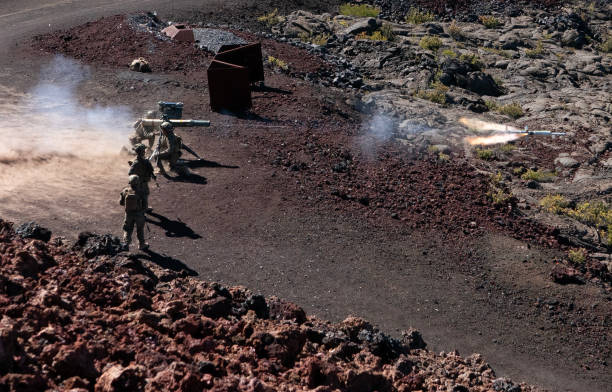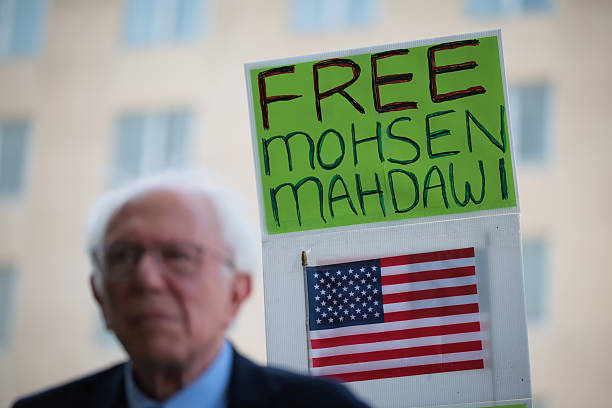Hawaii Land Board Rejects Army’s Environmental Study for Pohakuloa Lease Extension
The Hawaii Land Board rejected the U.S. Army’s environmental impact statement for the Pohakuloa Training Area lease extension, citing major environmental, cultural, and legal deficiencies.
 Hilo, United States - January 25 : Marines from the 3d Littoral Combat Team trains on the TOWS (anti-tank missile) range at the Pohakuloa Training Area in Hilo, HI on January 25, 2024. (Photo by Sarah L. Voisin/The Washington Post via Getty Images)
Hilo, United States - January 25 : Marines from the 3d Littoral Combat Team trains on the TOWS (anti-tank missile) range at the Pohakuloa Training Area in Hilo, HI on January 25, 2024. (Photo by Sarah L. Voisin/The Washington Post via Getty Images)HONOLULU — The U.S. Army’s efforts to retain training land at the Pohakuloa Training Area (PTA) on Hawaii island suffered a major setback Friday as the Hawaii Board of Land and Natural Resources (BLNR) voted to reject the Army’s final Environmental Impact Statement (EIS), citing data gaps and widespread public opposition.
The decision followed years of work and multiple draft submissions by the Army since 2022, culminating in a final EIS that board members and public commenters said failed to adequately address environmental, cultural, and legal concerns. Hundreds of people testified in person and via Zoom, overwhelmingly urging the board to reject the EIS, just days before the Army is set to host the Land Power in the Pacific Conference in Waikiki.
“The issue today is whether we should accept the EIS or not accept the EIS,” said BLNR Chair Dawn Chang. “It is only with respect to PTA. It is not on whether what the Army is doing is good or bad, or if we provide them land retention or not.”
The board found the EIS lacking critical updates and evaluations, including outdated biological surveys—the most recent from 2013—despite the discovery of two previously undocumented species, the yellow-faced bee and Blackburn’s sphinx moth. The EIS also failed to address the handling of significant funerary artifacts discovered in 2022 and did not sufficiently assess impacts on endangered species, groundwater, or traditional Native Hawaiian burial grounds.
Office of Hawaiian Affairs (OHA) Chair Kai Kahele praised the board’s decision, stating it “reflects a thorough review of the document’s legal, environmental, and cultural deficiencies,” and reaffirmed OHA’s commitment to protecting Native Hawaiian rights and public trust lands.
Following the vote, the Army stated it is observing a 30-day waiting period before finalizing its Record of Decision (ROD), which will determine the amount of land it seeks to retain. Negotiations on the terms—whether lease or purchase—will follow ROD confirmation.
DLNR emphasized that the EIS itself does not authorize land use and that any long-term lease request would require a separate review and board determination.
The Army has used PTA since World War II and secured the land for \$1 in 1964. The contested 22,750-acre state-owned parcel lies between two federally controlled sections, together comprising 132,000 acres. The Army considers the parcel essential, calling it the “connective tissue” of PTA and central to the Joint Pacific Multinational Readiness Center, which supports U.S. military readiness in the Pacific.
However, DLNR now designates the parcel as a conservation district, and staff concluded military activity does not align with this designation. The sub-alpine tropical dryland forest in the area is one of the world’s rarest ecosystems, home to endangered species including the nene and Hawaiian hoary bat.
Environmental and Native Hawaiian advocates swiftly celebrated the rejection. Maxx Phillips of the Center for Biological Diversity said the board’s vote “recognized that you can’t make informed decisions... when you refuse to even do baseline surveys.” Native Hawaiian Legal Corp. attorney Ashley Obrey said the ruling upholds Hawaii law prioritizing land and cultural health over military convenience.
Sierra Club of Hawaii director Wayne Tanaka called the decision a “once-in-a-lifetime chance” to end decades of environmental harm at Pohakuloa.
Army leaders acknowledged the concerns. Lt. Col. Tim Alvarado, who manages daily PTA operations, said the Army “understands and deeply respects the concerns expressed by community members” and aims to balance its training needs with environmental and cultural considerations.
The site has long been a focal point of litigation. In 1989, the Sierra Club sued the Army over bulldozing native forests without proper surveys. In 1993, an Army report found internal efforts to evade scientific review. In 2019, Hawaii’s Supreme Court ruled that the state failed to enforce the Army’s cleanup duties at PTA, upholding Native Hawaiian legal claims.
The Army’s lease requires “reasonable efforts” to remove ordnance after training, but the impact area is deemed too hazardous for regular cleanup. Critics said the EIS did little to evaluate potential risks to surrounding state lands.
A few individuals testified in support of the EIS. Waikoloa Village resident Matthew Chalker praised PTA’s firefighting facilities for protecting communities. BLNR member Riley Smith opposed the EIS rejection, citing Army good faith. Member Vernon Char, who abstained, said the testimony was emotional and occasionally misdirected.
The EIS was drafted under the Biden administration, but with leases expiring in 2029, the Trump administration and Defense Secretary Pete Hegseth will now oversee future decisions. Hegseth has proposed slashing environmental programs and civilian workforce roles that don’t “directly contribute to lethality,” raising questions about future stewardship at PTA.
Army Secretary Dan Driscoll previously promised to engage with Hawaii’s community and congressional leaders. Still, the direction under Hegseth may challenge those commitments.
PTA’s staff of about 200 includes scientists, archaeologists, and firefighters, although only five uniformed soldiers are stationed there when training is inactive. Col. Rachel Sullivan, commander of U.S. Army Garrison Hawaii, reiterated the Army’s commitment to stewardship and community partnership.
What lies ahead for the Army’s land retention efforts remains uncertain as the administration transition continues to reshape federal policy and military priorities.







Conversation